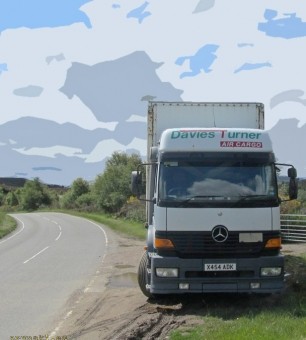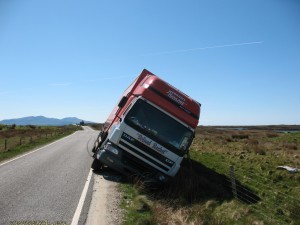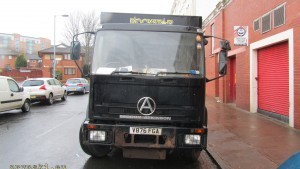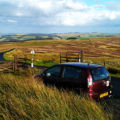 Huge engine of monstrous, 18 wheeled Juggernaut roars while it climbs the bendy mountain road. Inside, a microphone from CB radio hangs over the dashboard. Behind the wheel a hairy trucker in a baseball cap neglectfully bites his toothpick. From time to time glancing at amazing views behind the windscreen and a sexy hitch-hiker on the passenger’s seat. He is not in a rush, so he will probably decide to take a break when they reach the summit, where they will o watch the sunset, sitting on the still warm bonnet of his truck… This is a life many teenage boys dream about. But as it is with dreams, usually the reality is not that colourful.
Huge engine of monstrous, 18 wheeled Juggernaut roars while it climbs the bendy mountain road. Inside, a microphone from CB radio hangs over the dashboard. Behind the wheel a hairy trucker in a baseball cap neglectfully bites his toothpick. From time to time glancing at amazing views behind the windscreen and a sexy hitch-hiker on the passenger’s seat. He is not in a rush, so he will probably decide to take a break when they reach the summit, where they will o watch the sunset, sitting on the still warm bonnet of his truck… This is a life many teenage boys dream about. But as it is with dreams, usually the reality is not that colourful.
Driver number 1138
The romantic times of top runs to the Middle East or Pakistan are today the song of the past. They were gone when the combined transport took over. Today for the long distance, the cargo is moved in containers, which can be carried by the sea, air or by rail. Most of the trucks rarely go further than 100-200 km from their depots. The truckers of today are no longer travellers following the footsteps of Marco Polo. Today they are just numbers, a clock-wheel in a big transport machine. As the traditional craftsmen were replaced by mass production, the truck drivers, just like factory workers, are responsible only for their short segment on the line.
It is relatively easy to find a job on the last link of the delivery chain – that is because trucks here still play the major role. Delivering goods from warehouses to shops, delivering pallets to their final recipients, beverage and drinks distribution… A hard and poorly paid job, but there are some, who like it. And despite it is also known as “circulating around the chimney” there is still an element of adventure. Even if the driver has to visit the same places every day, every day is at least a bit different.
This is not the case for those drivers who work further down the delivery chain – so called trunk drivers. Their job is limited to moving cargo from one warehouse to another, from one factory to a distribution centre or from one transport depot to another. Despite they travel every day (or, more often, every night) much longer distances, they can rarely hope for some excitement. They rarely leave motorways and virtually all their trips look the same – few hours of driving, reload or swapping trailers and then back the same way.
Closest to this idealistic picture of our romantic adventure seems to be the work of a tramper. Tramper is a driver, who sometimes spends long days away from home, moving cargo as found for him in an ad hoc manner by his speditor. This one can expect that he will be going where the wind blows in a given moment. He can also forget about beautiful scenic routes or visiting tourist attractions. Most of the time he spends on the motorways, looking at the back doors of precedent lorry, or on the parking in front of huge, ugly warehouses made of metal. And then there is this constant fatigue…
Eat, sleep and use toilet as ordered…
The EU bureaucrats incessantly create new laws and regulations, which are supposed to ensure safety and make trucker’s lives easier. It seems though, that even if they had any contact with the reality of the transport industry, they must have lost it a long time ago. The idea of limiting drivers’ working hours to ensure they enjoy proper rest is completely understandable as it is good not only for the truckers, but for all of us, because it is us, who share the road with these 44 ton juggernauts. Nevertheless, the question if the current regulations bringus closer to this aim is discussable. Driver’s working hour regulations are getting more and more complicated. And so, the driver can drive for no more than 9 hours per day, provided that he makes a 45 minutes break after 4,5 hours of work. However, in some cases he can drive up to 10 hours per day. His day at work cannot be longer than 15 hours, including driving, other work and periods of rest. Even if he is not driving, he has to take a 30 minutes break after no later than 6 hours. He has to take at least 24 hours off weekly for rest, but in cars that is shorter than 45 hours, he has to “pay back” missing hours in the following weeks. When it comes to work limitations, he cannot drive for more than 56 hours per week, but the average two-weekly driving time cannot be more than 90 hours and the average from any 17 weeks…
 Stop! Stop it right now. I think this is enough. As you can see, it is very carefully described in the European law and the simplified results of the bureaucrat’s work may be found in a 58 paged leaflet issued by the institution responsible for enforcing these regulations – the British VOSA. The leaflet is printed on a beautiful chalky paper, it has many nitty pictures and pre-words from Important Bureaucrats with the big pictures of their faces. There is also plenty of nice drafts, graphs and schemes . This leaflet is handed out to every new driver together with his fresh truck driving license and the CPC certificate. Then they go on the road and it turns out that everything that is said in the leaflet is wrong.
Stop! Stop it right now. I think this is enough. As you can see, it is very carefully described in the European law and the simplified results of the bureaucrat’s work may be found in a 58 paged leaflet issued by the institution responsible for enforcing these regulations – the British VOSA. The leaflet is printed on a beautiful chalky paper, it has many nitty pictures and pre-words from Important Bureaucrats with the big pictures of their faces. There is also plenty of nice drafts, graphs and schemes . This leaflet is handed out to every new driver together with his fresh truck driving license and the CPC certificate. Then they go on the road and it turns out that everything that is said in the leaflet is wrong.
Despite the bureaucrat’s expectation, the reality somehow does not want to fit easily to their carefully created imaginary world. The truck parkings somehow are not located every 4.5 hours along the road, and even if there is some lay-bys, there is rarely any toilet, restaurant or shower which the driver could use. Traffic jams, diversions and road works are the reason for which the routes cannot be planned with the scale of hours, not to mention minutes. In addition, loading vehicles, and even more, waiting for the loading takes completely unpredictable amounts of time.
The bottom line is that the driver instead of driving when he is rested and resting when tired, drives when tachographs tell him to do so. He then tries to sleep when his daily limit of driving hours goes down. In other words, the tachographs instead of being the driver’s ally become a slave drivers. It does not take a psychology professor to figure out that if one day of driver’s work takes 15 hours and the next one takes as little as 9 hours, it is very easy to completely destroy his day/night pattern. And some people cannot sleep when the machine tells them to do so, especially at a crowded service area next to a busy motorway with an accompaniment of a fridge generator in a refrigeration lorry parked next to his cab.
Permanent Invigilation
But the driving hours are not the only field when the driver is under constant control. The fuel price is going up faster than rockets. Hauliers are forced to save money whenever possible. The first thing was to control the truck location. Constant satellite tracking provides the employer with knowledge of the driver’s whereabouts, that he did not go to the beach with his articulated lorry or that the trailer was not stolen. But at the same time, it provides his employee with constant entertainment of mobile phone calls and text messages. Who never had to answer insistent text messages from his boss “why are you stopped! You should be there already!” during long-expected defecation in a neglected roadside toilet, is not aware of what the life of a modern trucker is.
 So this was the moment when the joy of having work, where your boss is not constantly over your shoulder, finished. And it is not just the boss who is over your shoulder. There are dozens of satellites orbiting over your head and thanks to mobile phones the transport office can take hold of you any time, day or night. And there is no place to hide. And this is only the beginning…
So this was the moment when the joy of having work, where your boss is not constantly over your shoulder, finished. And it is not just the boss who is over your shoulder. There are dozens of satellites orbiting over your head and thanks to mobile phones the transport office can take hold of you any time, day or night. And there is no place to hide. And this is only the beginning…
Now the driving techniques are a new target of this invigilation. Computers constantly register fuel consumption, engine rpm’s, chosen gear (for those who still are lucky to use manual gearboxes), and several other parameters. After his return to base, the driver is taken to task, often by someone who does not even have an ordinary driving license. The driver then has to explain himself why two weeks ago in Lisbon he reeved his engine while starting from the junction, and why three weeks ago in Slovenia he used an upper 2 and a half and not 3. In many cases, his salary is made dependant on his ability to stick to the set brackets of tolerated deviation from set parameters developed by a perfect computer. What a shame that the conditions on the road are not that perfect…
Truckers as whipping boys
Everyone who at least once tried to cross a busy street knows that road traffic is not a perfect system. It is rather like a huge anthill in the panic caused by a pine cone, which fell on it. Millions of road network users are traveling in every direction following their own business. And this is how the traffic can be seen from behind the wheel of the big truck. Pedestrians, cyclists, even cars seen from above look just like these ants running around in panic. Especially if compared with a big lorry they are all swift, and can suddenly change their directions. Driving 40 tonner in these circumstances makes you feel like an elephant in a fine china shop. Our steel elephant is also very clunky and the other road users are as fragile as porcelain figures. But it is much worse with them – unlike the porcelain figures they do not just stand motionless. They all want to reach their destination as quickly as possible. This huge stumbling block wading through the sea of the welter of smaller road users spoils all smoothness of the road traffic. It accelerates annoyingly slowly, it has to go carefully around every bend and it needs much more time and space for every maneuver. And this is OUR time and space! Time and space we could use to get quicker to our homes, work, or girlfriends! This is just one of the reasons why not many people like to share their lives with trucks. Trucks are not only annoying to other drivers, they are also noisy, they cause vibrations, they block the view, they obstruct the road. The list of the anti-truck brigade may be endless: people from small towns and villages, drivers in a rush, owners of cars parked at the corners (“This is closer to my door, if not for that lorry no-one would be bothered with me parking there”)… It is hard to expect that everyone could look at the world from the trucker’s point of view, however even if they could, they are not interested to do so. “I don’t care, I just cannot stand when they are overtaking one another for 5 minutes on the motorway”. It is not important that if we slow down for a while from 130km/h to 90km/h, we would reach our destination a few dozens of seconds later and if the truck driver for few hours will be forced to drive 1 km/h slower, he might be forced to stop 3 km from his destination and spend there, in an extreme case, a few days… But why should we care about some trucker? We are in a hurry – we want to sit on our couch, eat olives and cheese and drink this good wine we bought in a local shop… But maybe it is worth sometimes to think about – this cheese and wine arrived in the shop not by themselves, but on board of one of these annoying juggernauts…
 And if there is only an accident. If only a truck got involved, the verdict of the public is obvious. After all, we all know how THEY drive. They are crazy people, psychopaths, murderers behind the wheel! Everyone can see it in the media – pile of scrap, bloodstain of a deployed airbag, and the truck driver who walks out of his slightly scratched cab as if nothing happened. This may be imprinted in our memory. But the statistics show us the real picture: it is actually not the professional drivers we should be afraid of on the road. Contrary to popular opinion they have few, if not several times fewer accidents per traveled mile than ordinary car drivers. This situation is similar to air transport. Statistically speaking it is the safest way to travel but hundreds of people are afraid of it because if some accidents happen, the outcome is usually very tragic. It is the same situation with big trucks. The vast majority of them travel hundreds of thousands of miles without any problems, but if something happens, these 40 tons of steel can cause real mayhem. And this is what causes this irrational fear in us, and to find someone to blame helps many people to get over it.
And if there is only an accident. If only a truck got involved, the verdict of the public is obvious. After all, we all know how THEY drive. They are crazy people, psychopaths, murderers behind the wheel! Everyone can see it in the media – pile of scrap, bloodstain of a deployed airbag, and the truck driver who walks out of his slightly scratched cab as if nothing happened. This may be imprinted in our memory. But the statistics show us the real picture: it is actually not the professional drivers we should be afraid of on the road. Contrary to popular opinion they have few, if not several times fewer accidents per traveled mile than ordinary car drivers. This situation is similar to air transport. Statistically speaking it is the safest way to travel but hundreds of people are afraid of it because if some accidents happen, the outcome is usually very tragic. It is the same situation with big trucks. The vast majority of them travel hundreds of thousands of miles without any problems, but if something happens, these 40 tons of steel can cause real mayhem. And this is what causes this irrational fear in us, and to find someone to blame helps many people to get over it.
On the Internet forums of ordinary car drivers, we can find hundreds of solutions, which can heal all problems caused by the trucks on the road. It is very typical of them to expect only truck drivers to do something about road safety. But if every car driver would commit 3 minutes of their life to learn when cars are in so-called ‘blind spot’ of the truck – that is, when the truck driver cannot see them – thousands of risky situations could be avoided. But no, it is better to splash all this crap on the Internet forums so that everyone can read that the only evil for which truck drivers are not responsible is the Fukushima nuclear disaster. And this is not only the forum users – the lawmakers seem to be of a similar view. Just to say, even slight, harmless offenses, such as driving a few minutes over the limit or moving the truck during the rest period, are punished with penalties much higher than are expected from other industries. Even such responsible professions as pharmaceutics or doctors, who care about our health and life, can get away with making much more severe and life-threatening mistakes… And since we are already talking about health…
A healthy mind in a healthy body
What can be found in the body of the trucker? Very often cardiac problems, back pains and a few extra kilos under the belt. A driving job is a job where you have to seat for most of your day. This is not helpful neither for your spine nor for your heart. And if we know that driver often eats very irregular meals (because they have to eat when they have time, not when they are hungry). The food of drivers is often very unhealthy (roadside restaurants are not the top of the tops when it comes to healthy living). All this together with a lack of exercise is responsible for obesity and cardiac problems. When it comes to heart problems it is not to be ignored that many drivers are heavy smokers. They smoke because they need relief from all the stressful situations on the road, to chase the sleepiness away, or simply out of boredom. Constant driving on a motorway with a speed of 90 km/h is too slow for any excitement but still too fast to allow even the slightest distraction.
 Here, the delivery drivers seem to be in a much better position. By working on the front line of the transport chain army they have at least some exercise. Unloading cages with goods, crates with drinks, or pulling heavy pallets on the pallet truck help them to burn some calories. But at the same time, this is a source of other problems. Often they have to lift too heavy items, which causes spinal injures and accidents. It is believed that most injuries in the transport industry happen during unloading. At least most the local drivers spend most of their nights at their own homes. This is not the case when we talk about long-distance drivers. They can rarely hope for a comfortable sleep. A truck parked in a roadside lay-by is rocked so hard by passing vehicles that one can get seasickness. On the motorway service area, you cannot count on silence even during the nighttime. During the hot summers, the truck cab can serve as an oven and in winter we have a choice between sleeping in cold or hearing a constant noise from the night heater. Even the slightest rain is like a cannonade on the roof. If there is a need to use the toilet, if one is lucky to be parked somewhere where it is accessible, it is sometimes like a big expedition to a rarely fulfilling basic hygiene standard unit a few hundred meters away.
Here, the delivery drivers seem to be in a much better position. By working on the front line of the transport chain army they have at least some exercise. Unloading cages with goods, crates with drinks, or pulling heavy pallets on the pallet truck help them to burn some calories. But at the same time, this is a source of other problems. Often they have to lift too heavy items, which causes spinal injures and accidents. It is believed that most injuries in the transport industry happen during unloading. At least most the local drivers spend most of their nights at their own homes. This is not the case when we talk about long-distance drivers. They can rarely hope for a comfortable sleep. A truck parked in a roadside lay-by is rocked so hard by passing vehicles that one can get seasickness. On the motorway service area, you cannot count on silence even during the nighttime. During the hot summers, the truck cab can serve as an oven and in winter we have a choice between sleeping in cold or hearing a constant noise from the night heater. Even the slightest rain is like a cannonade on the roof. If there is a need to use the toilet, if one is lucky to be parked somewhere where it is accessible, it is sometimes like a big expedition to a rarely fulfilling basic hygiene standard unit a few hundred meters away.
Born to be truckers…
But if it is so bad, why it is so good? Why this profession still attracts thousands of people of various ages and backgrounds? Why is it that not many truckers would tell you bad things about the job they do?
Well, the truth is that despite all of these disadvantages, it is still a job in which one can be alone with their thoughts. In this job you can still allow yourself to forget, for a while, that a computer tracks the slightest movement of your leg on the acceleration pedal. Just open the window slightly, turn up the radio and be happy that you do not have to be trapped within four walls. Some could say that the road is like a drug addiction – and it has to be true, because it is almost the rule that when someone quits this job and starts to work in some “stationary” profession, will always miss being on the road. And there is always that hope: there will come a day when we stop at the summit to watch a sunset with a beautiful girl…
This article was published in gazetae.com







[…] charts make guys in ties, who never even sat behind a wheel of the lorry, happy. I’ve been writing about this some time ago. But there are still places in which things are going in more traditional […]
[…] But the driver’s job is no longer a romantic adventure. It’s not all about driving towards the setting sun with the roar of your V8 diesel engine. More often than not it is just a hard graft for the big company that saves as much as possible on vehicles and for which you are only the number. And there is not much freedom left either – the drivers are dictated about the exact route they have to choose, and thanks to the developments in telemetry, their driving style is under constant observation (I wrote about it here). […]
[…] But the driver’s job is no longer a romantic adventure. It’s not all about driving towards the setting sun with the roar of your V8 diesel engine. More often than not it is just a hard graft for the big company that saves as much as possible on vehicles and for which you are only the number. And there is not much freedom left either – the drivers are dictated about the exact route they have to choose, and thanks to the developments in telemetry, their driving style is under constant observation (I wrote about it here). […]